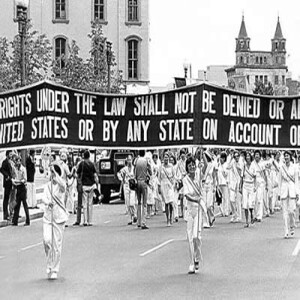
On this day in labor history, the year was 1972.
That was the day the Equal Rights Amendment passed the Senate and moved to the states for ratification.
It had passed the House the previous fall.
Alice Paul and Crystal Eastman of the National Women’s Party first wrote the ERA in the 1920s.
It was introduced to Congress in 1923.
The revised version that Congress passed in 1971 and 1972 stated simply “equality of rights under the law shall not be denied or abridged by the United States or by any State on account of sex.”
The amendment needed 38 states to ratify by March 1979, in order to pass.
35 states ratified the amendment, but 5 states later rescinded ratification.
The 38-state requirement was never met.
The decades long debate among women’s rights advocates often centered on formal equality vs. protective legislation for women workers.
But an amendment establishing equality meant the end to restrictive, discriminatory laws.
These included: laws imposing restrictions on a woman's right to buy or sell property or to conduct a business; the age at which women could marry; differing admissions standards for boys and girls in tax-supported educational institutions; laws establishing different jail sentences, by sex, for identical crimes; regulations denying unemployment compensation payments to pregnant women who are still able and willing to work and much more.
The far Right and religious fundamentalists of all faiths fiercely opposed the ERA, fearing it would erode traditional gender roles.
Many Progressives and the labor movement also opposed it for many years on the basis that hard-won protective legislation would be lost.
It is striking that as of 2017, there is still no clear legal codification of women’s equal status to men.
More Episodes
 2024-06-09
2024-06-09
 2024-06-02
2024-06-02
 2024-06-02
2024-06-02
 2024-06-02
2024-06-02
 2024-06-02
2024-06-02
 2024-06-02
2024-06-02
 2024-05-26
2024-05-26
 2024-05-26
2024-05-26
 2024-05-26
2024-05-26
 2024-05-26
2024-05-26
 2024-05-26
2024-05-26
 2024-05-26
2024-05-26
 2024-05-19
2024-05-19
 2024-05-19
2024-05-19
 2024-05-19
2024-05-19
 2024-05-19
2024-05-19
Create your
podcast in
minutes
- Full-featured podcast site
- Unlimited storage and bandwidth
- Comprehensive podcast stats
- Distribute to Apple Podcasts, Spotify, and more
- Make money with your podcast
It is Free
- Privacy Policy
- Cookie Policy
- Terms of Use
- Consent Preferences
- Copyright © 2015-2024 Podbean.com




